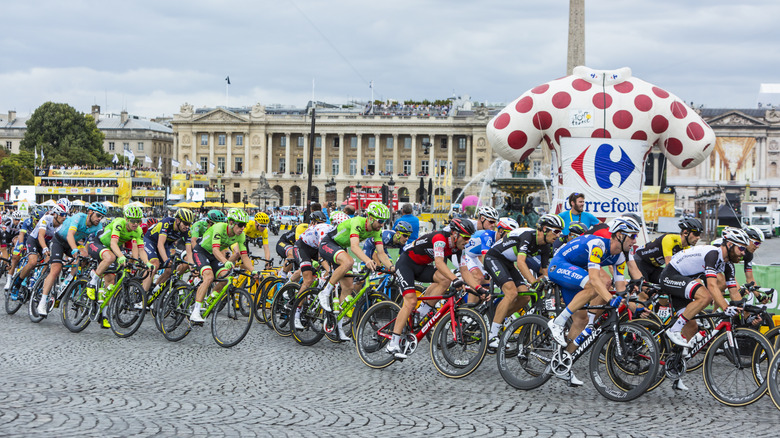Here's What Happens If You Lose The Tour De France
Although nobody wants to be last place in anything, various sports have found ways to mitigate the stigma of finishing at the bottom. For instance, the title of "Mr. Irrelevant" has been given to the last man picked in the NFL Draft since 1976 (via Sporting News), and one can say that it has inspired such players to work even harder to realize their pro football dreams. Then you've got the whole phenomenon of tanking, where bad teams seemingly embrace their cellar-dweller status and keep losing games in hopes of getting the No. 1 pick in the coming season's draft, as explained by SB Nation. While pro wrestling may be predetermined, there's a lot of underdog love for the jobbers, or enhancement talents — nondescript guys who are paid to make their established opponents look good by taking the quick loss.
Cycling may not be as popular with most sports fans as football, basketball, baseball, and soccer (or even wrestling) may be, but it has certainly produced its share of icons, including, but definitely not limited to the very controversial Lance Armstrong. But just like the aforementioned sports, cycling — and the Tour de France, in particular — has a way of recognizing the person who finishes in last place during the prestigious event. Most fans may remember Armstrong and various other Tour de France champions, but what specifically happens to the guy at the very back of the pack after the official results are in?
The origin of the Tour de France's Lanterne Rouge
According to Cyclist, the Lanterne Rouge — French for "red lantern" — is an unofficial honor given to the person who finishes dead last at the Tour de France. It was named for the red safety lanterns located on the back of passenger trains' rear vehicles and was first awarded in 1903 to Arsène Millochau, who came in 21st out of the 21 riders who made it to the finish line in the event's very first iteration. As pointed out by the publication, Millochau may have finished a combined 65 hours behind the winner, but he effectively outperformed the 39 competitors who dropped out of the race, as well as the other riders who were listed as official starters but didn't even get to compete.
So what's in it for the rider named Lanterne Rouge at the end of any given Tour de France? As explained by Cyclist, none of them are given special jerseys, and they don't get monetary rewards from the organizers for their apparent futility. Instead, they often receive paper lanterns from "Tour photographers looking for good pictures to sell." The title has also been criticized by some as a "celebration of failure" or a cheap consolation prize for the "heroic loser," but the outlet noted that those designated as Lanterne Rouge have often become fan favorites, either because of their underdog status or because they are the "most human" riders in a field of hyper-talented cyclists.
Sometimes it literally pays to be dead last
The Lanterne Rouge may not be official, but the riders who have been given this honor have often ended up much better financially for their last-place status. Per Cyclist, competitors from smaller teams usually had the most to gain, as the ensuing media coverage ensured "cold, hard cash" when they would compete in post-Tour de France events and collect substantial appearance fees. This was especially true from the 1950s to the 1970s, when the average cyclist struggled to make ends meet due to their low salaries. "For a journeyman pro on a low wage and with uncertain job prospects, the idea of a well-paid invitation to a two-week party was very alluring," wrote Max Leonard in his aptly-titled book "Lanterne Rouge," as quoted by The Guardian.
One example of a Lanterne Rouge who made a killing from post-Tour appearances was Abdel-Kader Zaaf, who finished last in 1951. That year, he was making only seven to 10 francs a day, but during the two-week period following the 1951 Tour, he supposedly earned a whopping 35,000 francs. As such, it's little wonder that the "race for last place" was very much a thing in the years that followed.
Some recent Lanternes Rouge earned much greater recognition after finishing last
Of course, earning big money is just one of the ways in which a cyclist can earn recognition and/or success in their sport, and there have been some Lanternes Rouge who eventually became better known for far more than their last-place classification. Sam Bennett (pictured) is one such example, as he had little success in his first two Tours, failing to finish in 2015 and getting named Lanterne Rouge in 2016. As reported by Cycling Weekly, he returned to the Tour de France in 2020, and third time proved to be the charm as he became the first Irishman to take the green jersey for highest points total in the general classification since 1989.
In 2018, American rider Lawson Craddock became the first Lanterne Rouge to hold last place in each and every stage of the Tour de France, according to The Guardian. However, he won the hearts of fans in a completely different way than Bennett, as his unfortunate crash in the first stage inspired him to set up a GoFundMe page for the hurricane-damaged Alkek Velodrome in his hometown of Houston. That campaign eventually raised more than $250,000 as fans applauded him for finishing the race despite the multiple injuries he suffered in the crash — as Craddock later said, the success of his fundraising initiative "made all the suffering worth it."



